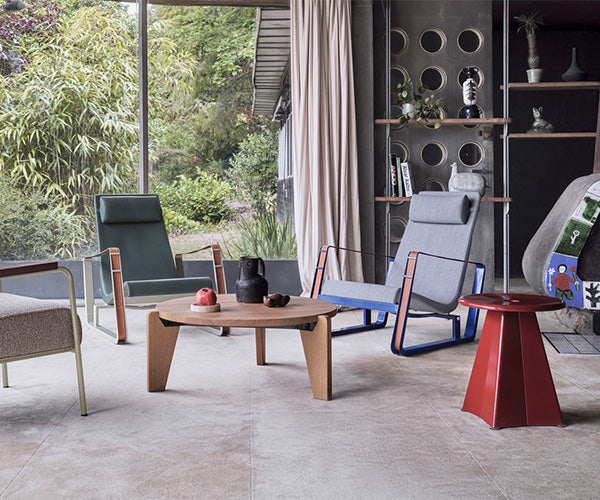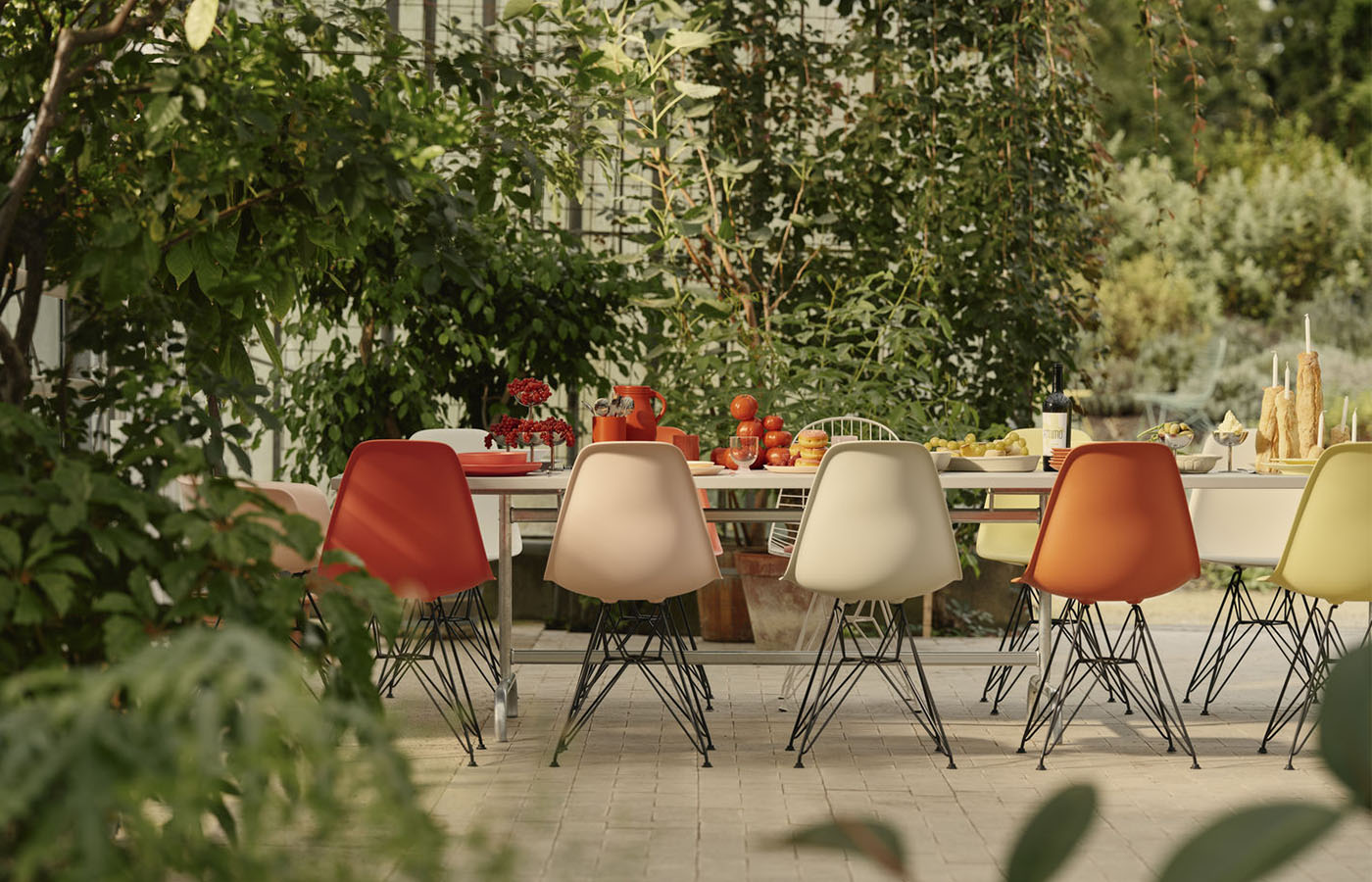I met Justin at home (online) in his sun-filled Brighton townhouse. He’s the kind of person you could talk to forever, speaking with passion about design, having worked at Knoll for over thirty years.
We covered the importance of materiality, the stories and life that get passed down through the pieces of furniture we buy, and much more. We hope you enjoy reading this conversation as much as we enjoyed having it.

Hi Justin, can you tell me a little bit about where you live?
“Yes! We live in Brighton. My wife and I have lived in a few places, and I don’t know how we ended up living in Brighton, but we did. It's a great place to live. A city with its challenges but there’s always something going on. We’ve got the sea, the (South) Downs. We love it. “
Can you tell us a bit about how you came to work for Knoll?
“I’ve been here thirty years so I am embedded in the business. I originally started working in the desking business and eventually moved into the retail side with the classic Knoll products, known to many as the Knoll Collection.
Originally, I did a design degree, and came from another desking business in Manchester to Knoll. I ended up falling in love with the company because I have a fundamental deep seated respect for what we do. We have an awesome back catalogue of products and have done incredible things recently.
When I arrived at Knoll, we had the Barcelona Chair, and the Saarinen Tables, they were there and part of the catalogue but primarily we were a desking business, that’s what we did.
Over time our offering broadened out to include more residential Knoll pieces, which had always sold well in the USA.
Can you tell us about Florence Knoll? She was quite a woman, and hugely influential in a male-dominated world.
“Yes, there’s a lovely picture of Florence in a room full of men. I think it was taken at the big American architects, SOM (Skidmore, Owings & Merril) office. A room full of white men wearing shirts and ties and Florence. She was a very strong and determined character.
But she was also an orphan, who had been half-adopted by Eliel Saarinen, who was the director of Cranbrook in the US and she was a friend of their son, Eero. She was a student of Mies and became an intern for Marcel Breuer - she had quite a group of friends!
What does good design mean to you?
“One of my favourite products is this IKEA watering can.”
(Justin shows me his two IKEA watering cans, in black and pink).
“It costs £1.50.
The way the water pours up the spout, the way the handle is made out of the same moulding. It’s a very pretty piece of design but again, it was designed to cost £1.50.
Things are designed to be what they are. They don’t need to be copied.
If I think about the strand between my watering can and, say, the Cesca, the Cross Check Chair and marble Saarinen Table, the link is materiality. That’s the connection that I’m very drawn to. The amazing use of materials.
The products we design at Knoll are not mass-produced like the watering can. They are different. but at both ends of the scale can be beautiful but they serve a different purpose.”
What are your favourite pieces in the Knoll Studio Collection?

Gehry Cross Check Chair
The Gehry Cross Check Chair is inspired by the surprising strength of the apple crates Frank Gehry played on as a child. The ribbon-like designs transcend style conventions by exploring the challenge of deriving form from function, as all the great modernists did.
“I love the Gehry Cross Check Chair. It’s such an amazing use of materials. It’s a piece of sculpture and remarkably comfortable.”

Cesca Chair
Marcel Breuer married traditional craftsmanship with industrial methods and materials to help make tubular steel furniture an international sensation and a modern institution. The cantilevered form exploits the possibilities that are unique to the material and gives the chair added flexibility and comfort. The iconic seat features woven cane inserts.
“I am having a love affair with the Cesca Chair too. It was the first, I believe, commercially produced steel cantilever chair. It was right at the forefront of what technology and what materiality would allow, and it was created a hundred years ago.
I love it.
It’s been copied a million times, but it’s the original. Thirdly, the Wassily Chair too is an incredible piece of design.”

The Wassily Chair
Designed by Marcel Breuer in 1925, the Wassily Chair became an instant classic of modern design, and even today it remains one of the most recognisable examples of Bauhaus design. He used the newest innovations in bending tubular steel for the structural frame, demonstrating the possibilities of modern industry applied to everyday objects.
“It’s a deconstruction of an armchair. The webbing, the padding, the wooden frame have all been removed. It bears it out to its skeletal components. That’s pretty radical. It’s almost like going from a horse-drawn carriage to a train in design terms. It’s a fundamental design step.
Because we’ve seen it a thousand times, we kind of ignore what it is but it's an unbelievably clever and considered piece of design. It is quite remarkable.”
Made to last
One of the things that Justin feels strongly about is that furniture should be made to last, an ethos that we at Cimmermann believe too. We talk about the idea that furniture is a vessel that carries our stories to the generations that come after us.
“On one of the very early days at Knoll, I had a phone call from a gentleman who had inherited a Bertoia Bird Chair. The call was full of the emotion of the recent death of his father. The chair meant an awful lot to him as he had grown up with it. It is a Bertoia Chair and we can supply new parts and upholstery, and bring the chair back to life for him, so we did. It meant a huge amount to him and me.
It struck me then that this isn’t just about furniture. This is furniture that you inherit. You have it a lifetime and you pass it on. It has a value.
This is what Knoll is about.
Make it right and make it once. Then, keep it for fifty years.”
To demonstrate, Justin turns around to show me his Saarinen Table which is the centrepiece of the room.
“This table is nearly 30 years old. It's been beaten up by three children. It’s been covered in spaghetti bolognese more times than I can imagine. It’s been covered in poster paint, and if I step off this mortal coil in 25 years' time when it's 55 years old or something, it'll still have value. Whether the children sell it or use it themselves, it will still be here after all that time.”

Can you tell us a bit about your home?
“It’s a typical Brighton townhouse.
We originally designed the space because we had three young children at the time. We wanted to have one big living space, down here.
We worked with a local firm, Lomax, Cassidy and Edwards to do it and they came in with a clever cohesive plan.
We wanted to create direct access to the garden so they came up with the idea of this wide staircase. So, it was very much designed around family life with children.
From a design brief perspective, I love the work of John Pawson. I love the idea of a minimalist space, where the materials shine through.
When I was a student, I always imagined that I would have a bedroom with a glossy, black floor, perfectly white walls, and a single futon in the middle of the floor.
I think I saw something similar that John Pawson had done.
Funnily enough, It didn't quite turn out like that.
There’s a BBC Radio 4 programme at that moment with Thomas Heatherwick, called Building Soul. I haven’t listened to it all yet but it’s about designing buildings that actually make people feel good. What makes you feel comfortable.
One of the premises is that Modernist buildings don’t make you feel comfortable. I fully disagree. I think modernist buildings can be full of soul and character, but completed badly by poor planners and developers without consideration to their actual use you get buildings that are the lowest common denominator and sadly our country is full of them.
I like modernism because I like order, I think. I love the idea of a clean, modernist building with beautiful materials because they tend to go hand in hand.
I think order is important to me. But then you decorate a home with the things that give you pleasure and that’s what gives it the character.”

Tell us about the things you love in your home
“There's lots of things. The Saarinen Table is hard to beat. It could be a cliche, but it is an extraordinary design. It’s the single most famous table in the world. There are plenty of globally famous chairs, but only one table as renowned as this.
My favourite design of all time is probably the Gehry Cross Check Chair, but I love all sorts of things for different reasons.
We have an old shepherd’s chair upstairs which belonged to my parents. It’s a very beautiful shape and I’m sure it has got a thousand stories to it.
I think that’s the thing. Our lives are transient. In one hundred years we will all be long-buried. There will be no memories of us. But these are our memories now, our associations, and it's what we surround ourselves with.”
Where do you look for inspiration?
“The answer is I don't really “go” anywhere, I don’t go looking for it. But I think inspiration is everywhere. I spend my life looking at the details of things. In shops for instance, it could be the fittings or the way two bits of wood meet or in Coventry Cathedral seeing how the columns seemingly float above the floor.It could be a junction between a wall and a flooring, and I’m looking at how they’ve created that kind of particular gap and what a proportioned thing it is.”
Shop the Knoll collection







Leave a comment (all fields required)